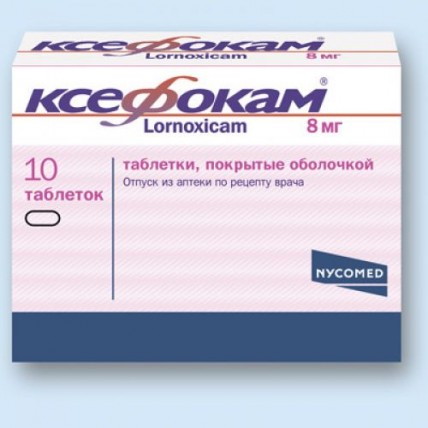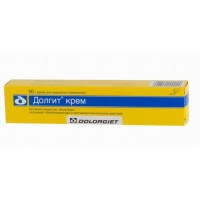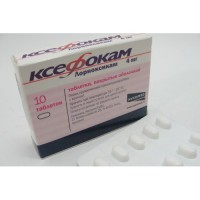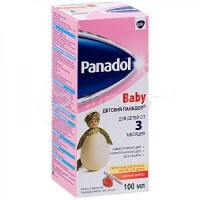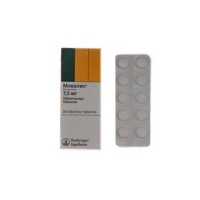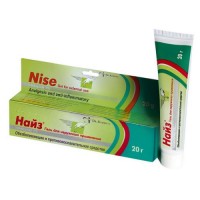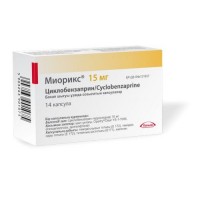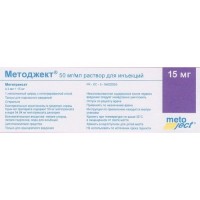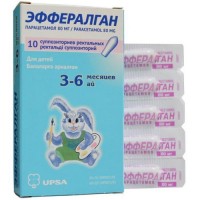Ksefokam 10s 8 mg coated tablets
- $9.60
The instruction for use of medicine for experts of KSEFOKAM the Trade name Ksefokam Mezhdunarodnoye the unlicensed name Lornoksikam Lekarstvennaya the Tablet form, film coated 4 mg and 8 mg Structure One tablet, film coated, contains active agent - to lornoksika of 4 mg or 8 mg, excipients: magnesium stearate, povidone, sodium of a kroskarmelloz, cellulose microcrystalline, lactoses monohydrate, a macrogoal 6000, the titan dioxide (E 171), talc, a gipromelloza 5, the water purified the Description of the Tablet of oblong shape, film coated from white till yellowish color with the inscription L04 (for a dosage of 4 mg) Tablets of oblong shape, film coated from white till yellowish color, with the inscription L08 (for a dosage of 8 mg) Pharmacotherapeutic group Anti-inflammatory and antirheumatic drugs. Non-steroidal anti-inflammatory drugs. Oksikama. Lornoksikam the ATX M01AC05 Code the Pharmacological Lornoksikam Pharmacokinetics properties is quickly and almost completely soaked up from the digestive tract (DT) after intake. At the same time the maximum concentration in plasma (Cmax) is reached approximately in 1 – 2 hour. Meal reduces the maximum concentration (Cmax) by 30% and raises time of achievement of the maximum concentration (Tmax) till 2.3 o'clock. The absolute bioavailability of a lornoksikam is 90 – 100%. Lornoksikam is present at plasma in an invariable look and also in the form of a hydroxylated metabolite which has no pharmacological activity. Extent of linking with proteins of plasma makes 99% and does not depend on concentration. Elimination half-life averages 4 hours and does not depend on concentration of drug. Lornoksikam is completely metabolized in a liver. CYP2C29 isoenzyme participates in metabolism. About 2/3 it is removed through a liver and 1/3 through kidneys in the form of inactive connection. It is removed with breast milk. At elderly people and at patients with abnormal liver functions and kidneys are not revealed significant changes of pharmacokinetics of a lornoksikam. The pharmacodynamics Lornoksikam represents non-steroidal anti-inflammatory drug (NPVP) with analgetic action. Oppression of synthesis of prostaglandins owing to the balanced oppression of activity of isoenzymes of cyclooxygenase-1 and cyclooxygenase-2 is the cornerstone of the mechanism of action of a lornoksikam. Besides, to lornoksika inhibits release of oxygen radicals from the activated leukocytes. Lornoksikam does not possess opiatopodobny action on the central nervous system and therefore breath does not oppress and also does not cause constipations and miotic effect. There are also no bases to assume possibility at patients of medicinal dependence to a lornoksikam. Indications - short-term treatment of a pain syndrome of various origin - symptomatic treatment of pain and inflammation in an osteoarthritis - symptomatic treatment of pain and inflammation in a pseudorheumatism the Route of administration and doses Inside at the moderate and expressed pain syndrome is recommended a dose of 8 - 16 mg 2 – 3 times a day. The maximum daily dose – 16 mg. In inflammatory and degenerative rheumatic diseases the recommended initial dose of 12 mg/days. The average dose makes 8 – 16 mg/days, depending on a condition of the patient, frequency rate of reception – 2 times/days, the maximum daily dose – 16 mg. The pill Ksefokama is taken inside before food, washing down with a glass of water. In gastrointestinal diseases, at patients with disturbances of kidneys or a liver, at elderly people (65 years are more senior) the maximum daily dose makes 12 mg 2 – 3 times a day. For reduction of risk of development of the undesirable phenomena from a GIT it is necessary to use a minimal effective dose minimum possible short course. Side effects Often: a headache, dizziness an abdominal pain, dyspepsia, nausea, vomiting, diarrhea Infrequently anorexia, change of weight insomnia, a depression conjunctivitis dizziness, sonitus heartbeat disturbance, tachycardia, heart failure hypostases (peripheral and generalized) rhinitis a constipation, a meteorism, an eructation, dryness in a mouth, ulcers in an oral cavity increase in level of hepatic transaminases, an abnormal liver function rash, an itching, erythematic rash, a small tortoiseshell and a Quincke's edema, an alopecia, perspiration, hyperaemia an arthralgia an indisposition, a face edema Seldom: a melena, vomiting with blood, an esophagitis, gastritis, a gastroesophageal reflux, a dysphagy erosive cankers of a mucous membrane of a stomach and intestines, including with perforation and bleeding aphthous stomatitis, a glossitis, pharyngitis, an asthma, cough, a bronchospasm anemia, thrombocytopenia, a leukopenia, increase in a bleeding time hypersensitivity, anaphylactoid reaction and an anaphylaxis confusion of consciousness, nervousness, excitement, drowsiness, paresthesia, a tremor, migraine disturbance of taste a disorder of vision a hypertension, inflows, bleeding, hematomas an ostealgia, muscular spasms, myalgia a nocturia, urination disturbance, increase in level of creatinine and urea nitrogen in blood serum an asthenia dermatitis and eczema, a purpura Very seldom a neutropenia, an agranulocytosis, aplastic and hemolytic anemia the aseptic meningitis arising mainly at patients with a system lupus erythematosus or the mixed diseases of connective tissue a liver failure, hepatitis, jaundice, a cholestasia an edematous syndrome, bullous reaction, Stephens-Johnson's syndrome, the Lyell's disease an acute renal failure, interstitial nephrite, a nephrotic syndrome. Contraindications hypersensitivity to a lornoksikam, acetylsalicylic acid or other NPVP of the instruction in the anamnesis on bronchial asthma, a small tortoiseshell and rhinitis thrombocytopenia heavy heart failure gastrointestinal, cerebrovascular and other bleedings or suspicion of bleeding, fibrillation disturbance a peptic ulcer of a stomach and duodenum in an aggravation phase, in the anamnesis of bleeding from a GIT, NPVP connected with reception the profound liver failure the profound renal failure (level of serumal creatinine & gt, 700 µmol/l) children's and youthful age up to 18 years pregnancy and the period of a lactation. Medicinal interactions At simultaneous use of the drug Ksefokam and: Cimetidinum concentration of a lornoksikam in plasma of blood increases, interactions with ranitidine and antiacid drugs it is not revealed, anticoagulants or inhibitors of aggregation of thrombocytes - increase in a bleeding time and increase in risk of developing bleeding (control of the international normalized MNO relation is necessary) is possible, β-adrenoblockers and APF inhibitors can reduce their hypotensive effect, diuretics – the diuretic effect and hypotensive action by digoxin decreases – reduces renal clearance of digoxin, hinolonovy antibiotics risk of development of a convulsive syndrome increases, other non-steroidal anti-inflammatory drugs and glucocorticoids - the risk of a GIT of bleedings increases, a methotrexate concentration of a methotrexate in serum, selective serotonin reuptake inhibitors increases (for example, a tsitaloprama, fluoxetine, a paroksetin, sertraline) increases risk of a GIT of bleedings, salts of lithium can cause increase in the maximum concentration of lithium in plasma and by that strengthening of the known side effects of lithium, cyclosporine increases nephrotoxicity of cyclosporine, derivatives of sulphonylurea is possible strengthening of hypoglycemic effect of the last, the pemetrekseda can reduce clearance of a pemetreksed. alcohol, corticotropin, drugs of potassium increase in risk of by-effects from a GIT is possible, a tsefamandola, a tsefoperazona, a tsefotetana, valprovy acid the risk of bleeding increases. Special instructions Renal failure: At patients with a renal failure (level of serumal creatinine of 150 - 300 µmol/l), in heart failure, in the abnormal liver function and other states causing decrease in volume of the circulating blood and a renal blood-groove carry out continuous clinical monitoring, control of function of kidneys (for example, on the level of serumal creatinine) and a liver. Long-term treatment (more than 3 months): It is regularly recommended to carry out the assessment of a condition of blood (hemoglobin), functions of kidneys (creatinine) and liver enzymes. To patients 65 years, or with body weight less than 50 kg are more senior, or transferred extensive surgeries it is recommended to enter smaller doses of Ksefokam. The total daily dose should not exceed 8 mg. At prolonged use of the drug Ksefokam it is necessary to control a pattern of peripheral blood and also indicators of function of a liver and kidneys. Gastrointestinal ulcers and bleedings in the anamnesis. Carrying out clinical observation is recommended. In a round ulcer of a stomach and a peptic ulcer of a duodenum the therapy by Ksefokam should be carried out against the background of intake of inhibitors of a proton pomp (pantoprazol). It is not necessary to apply along with other NPVP. Patients it is necessary to be careful with existence in the anamnesis of hypertensia and/or heart failure, drug can cause a delay of water and sodium, peripheral swell also arterial hypertension. At emergence of signs of damage of a liver (skin itching, yellowing of integuments, nausea, vomiting, an abdominal pain, urine darkening, increase in level of hepatic transaminases) it is necessary to stop administration of drug and to see the attending physician. As well as other oksikama, Ksefokam oppresses aggregation of thrombocytes and therefore can increase a bleeding time. At use of this drug it is necessary to watch attentively a condition of the patients needing absolutely normal functioning of a system of fibrillation (for example, patients, to whom is necessary surgical intervention), having disturbances of a system of fibrillation or receiving the medicines oppressing coagulation (including heparin in low doses) in due time to find symptoms of bleeding. Patients with a rare hereditary disease of intolerance of glucose and a galactose or malabsorption of a galactose should not use the drug Ksefokam. Use of drug can negatively affect female fertility and is not recommended to the women planning pregnancy. Features of influence of medicine on ability to run the vehicle or potentially dangerous mechanisms. It is necessary to refrain from control of the vehicles and other mechanisms requiring special attention because of the probability of dizzinesses and drowsiness. Overdose Symptoms: nausea and vomiting, cerebral symptoms (the dizziness, an ataxy passing into a coma and spasms). Changes of function of a liver and kidneys, disturbances of blood clotting are possible. Treatment: it is necessary to stop drug intake, symptomatic treatment. Thanks to short elimination half-life, lornoksika it is quickly brought out of an organism. Lornoksikam is not exposed to dialysis. So far specific antidote is not known. Intake of activated carbon right after administration of drug Ksefokam can promote decrease in absorption of this drug. For elimination of the gastrointestinal disturbances caused by the drug Ksefokam it is possible to use an analog of prostaglandin or ranitidine. The form of release and packing On 10 tablets place in blister strip packaging from a film of polyvinylchloride and aluminum foil On 1 planimetric packing together with the instruction for medical use in the state and Russian languages put in a pack cardboard. To Store storage conditions at a temperature not above 30 °C. To store out of children's reach! A period of storage 3 years not to use drug after expiry date Prescription status According to the prescription of Proizvoditel Takeda GmbH, Oraniyenburg, Germany the Name and the country of the owner of the registration certificate Takeda Austria GmbH, Austria the Name and the country of the organization packer Takeda GmbH, Oraniyenburg, Germany
to Develop the Address of the organization accepting in the territory of the Republic of Kazakhstan claims from consumers on quality of products (goods) Representative office Takeda Osteuropa Holding GmbH (Austria) in Kazakhstan Almaty, Shashkin St. 44
to Develop the Address of the organization accepting in the territory of the Republic of Kazakhstan claims from consumers on quality of products (goods) Representative office Takeda Osteuropa Holding GmbH (Austria) in Kazakhstan Almaty, Shashkin St. 44
